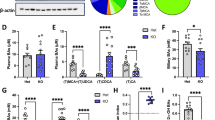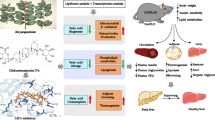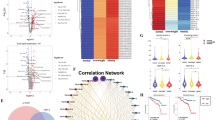Abstract
Aim:
Xuezhikang (XZK), an extract of red yeast rice, has been widely used in traditional Chinese medicine to treat cardiovascular disease. Three fractions F1, F2 and F3 (primarily containing isoflavones, monacolins or phytosterols, respectively) are extracted from Xuezhikang capsules. In this study we evaluated the lipid-lowering effects of these fractions and explored the potential mechanisms of actions.
Methods:
Mice treated with a high-fat diet (HFD) were orally adminis¬tered lovastatin (10 mg·kg−1·d−1), XZK (1200 mg·kg−1·d−1), F1 (27.5 mg·kg−1·d−1), F2 (11.3 mg·kg−1·d−1) or F3 (35 mg·kg−1·d−1) for 10 weeks. Lipids were measured using commercial enzymatic kits, and the mRNA and protein levels of genes involved in cholesterol and bile acid homeostasis were evaluated using qRT-PCR and Western blot analysis, respectively.
Results:
XZK increased the fecal excretion of lipids and bile acids, reduced serum TC, TG and LDL-C levels by 40%, 55% and 46%, respectively, and increased serum HDL-C by 31%. Administration of F1 repressed serum TC and TG by 24% and 52%, respectively, and elevated hepatic synthesis of CYP7A1. It also increased hepatic elimination of bile acids in the fecal excretions by 79% through upregulating BSEP and downregulating NTCP. Administration of F3 decreased serum TC, TG and LDL-C levels by 33%, 29% and 39%, respectively, and increased serum HDL-C by 28%, sig¬nificantly reduced intestinal absorption of cholesterol by inhibiting the transcription of NPC1L1, and elevated excretion of TC, FC and CE by 96%, 72% and 101%, respectively. Administration of F2 showed pharmacological effects similar to those of lovastatin.
Conclusion:
Isoflavones and phytosterols in XZK exert cholesterol-lowering effects in HFD mice through mechanisms that differ from those of lovastatin. Isoflavones and phytosterols act in a complimentary manner: through enhancing the elimination of bile acids and reducing intestinal cholesterol absorption, respectively.
Similar content being viewed by others
Log in or create a free account to read this content
Gain free access to this article, as well as selected content from this journal and more on nature.com
or
References
Chen ZY, Ma KY, Liang YT, Peng C, Zuo YY . Role and classification of cholesterol-lowering functional foods. J Funct Foods 2011; 3: 61–9.
Gropper SS, Smith LJ, Groff LJ . Advanced nutrition and human metabolism. 7th ed. Ohio (USA): Peter Marshall, Wadsworth; 2005.
Ma JY, Li YG, Ye Q, Li J, Hua YJ, Ju DJ . Constituents of red yeast rice, a traditional Chinese food and medicine. J Agr Food Chem 2000; 48: 5220–5.
Wei W, Li CL, Wang YY, Su HD, Zhu JS, Kritchevsky D . Hypolipidemic and anti-atherogenic effects of long-term Cholestin (Monascus purpureus-fermented rice, red yeast rice) in cholesterol fed rabbits. J Nutr Biochem 2003; 14: 314–8.
Lee CL, Tsai TY, Wang JJ, Pan TM . In vivo hypolipidemic effects and safety of low dosage Monascus powder in a hamster model of hyperlipidemia. Appl Microbiol Biot 2006; 70: 533–40.
Lin CC, Li TC, Lai MM . Efficacy and safety of Monascus purpureus Went rice in subjects with hyperlipidemia. Eur J Endocrinol 2005; 153: 679–86.
Heber D, Yip I, Ashley JM, Elashoff DA, Elashoff RM, Go VLW . Cholesterol-lowering effects of a proprietary Chinese red-yeast-rice dietary supplement. Am J Clin Nutr 1999; 69: 231–6.
Li CL, Zhu Y, Wang YY, Zhu JS, Chang J, Kritchevsky D . Monascus purpureus-fermented rice (red yeast rice): a natural food product that lowers blood cholesterol in animal models of hypercholesterolemi. Nutr Res 1998; 71–81.
Wang JJ, Pan TM, Shieh MJ, Hsu CC . Effect of red mold rice supplements on serum and meat cholesterol levels of broilers chicken. Appl Microbiol Biot 2006; 71: 812–8.
Liu JP, Zhang J, Shi Y, Grimsgaard S, Alraek T, Fonnebo V . Chinese red yeast rice (Monascus purpureus) for primary hyperlipidemia: a meta-analysis of randomized controlled trials. Chin Med 2006; 1: 4.
Grieco A, Miele L, Pompili M, Biolato M, Vecchio FM, Grattagliano I, et al. Acute hepatitis caused by a natural lipid-lowering product: When “alternative” medicine is no“alternative”at all. J Hepatol 2009; 50: 1273–7.
Klimek M, Wang S, Ogunkanmi A . Safety and efficacy of red yeast rice (Monascus purpureus) as an alternative therapy for hyperlipidemia. J Clin Pharm Ther 2009; 34: 313–27.
Heber D, Lembertas A, Lu QY, Bowerman S, Go VLW . An analysis of nine proprietary Chinese red yeast rice dietary supplements: implications of variability in chemical profile and contents. J Altern Complem Med 2001; 7: 133–9.
Manzoni M, Rollini M . Biosynthesis and biotechnological production of statins by filamentous fungi and application of these cholesterol-lowering drugs. Appl Microbiol Biot 2002; 58: 555–64.
Trimarco B, Benvenuti C, Rozza F, Cimmino CS, Giudice R, Crispo S . Clinical evidence of efficacy of red yeast rice and berberine in a large controlled study versus diet. Med J Nutrition Metab 2011; 4: 133–9.
Shang QH, Liu ZL, Chen KJ, Xu H, Liu JP . A systematic review of Xuezhikang, an extract from red yeast rice, for coronary heart disease complicated by dyslipidemia. Evid-Based Compl Alt 2012; 2012: 1–18.
Ma KY, Zhang ZS, Zhao SX, Chang Q, Wong YM, Yeung SYV, et al. Red yeast rice increases excretion of bile acids in hamsters. Biomed Environ Sci 2009; 22: 269–77.
Becker DJ, Gordon RY, Halbert SC, French B, Morris PB, Rader DJ . Red yeast rice for dyslipidemia in statin-intolerant patients: a randomized trial. Ann Intern Med 2009; 150: 830.
Bartley GE, Yokoyama W, Young SA, Anderson WHK, Hung SC, Albers DR, et al. Hypocholesterolemic effects of hydroxypropyl methylcellulose are mediated by altered gene expression in hepatic bile and cholesterol pathways of male hamsters. J Nutr 2010; 140: 1255–60.
Gordon RY, Cooperman T, Obermeyer W, Becker DJ . Marked variability of monacolin levels in commercial red yeast rice products: buyer beware!. Arch Intern Med 2010; 170: 1722–7.
Kidambi S, Patel SB . Cholesterol and non-cholesterol sterol transporters: ABCG5, ABCG8 and NPC1L1: a review. Xenobiotica 2008; 38: 1119–39.
Liu ZL, Liu JP, Zhang AL, Wu Q, Ruan Y, Lewith G, et al. Chinese herbal medicines for hypercholesterolemia. Cochrane Database of Systematic Reviews 2011, no. 7, Article ID CD008305.
Joint Commission on China Adult Dyslipidemia Prevention Guildeline. China adult dyslipidemia prevention guildeline. Chin J Cardiol 2007; 35: 390–419.
Dai XH, Zhuo XZ, Xue XY, Yang WM, Yu XQ, Zhou YX . Xuezhikang capsule for unstable angina pectoris. Tradit Chin Drug Res Clin Pharmacol 1999; 10: 202–4.
Wang WH, Zhang H, Yu YL, Ge ZC, Xue C, Zhang PY . Effect of Xuezhikang for patients with acute coronary syndrom complicated with different serum lipid levels. Chin J Integr Med 2004; 24: 1073–6.
Li JJ, Hu SS, Fang CH, Hui RT, Miao LF, Yang YJ, et al. Effects of xuezhikang, an extract of cholestin, on lipid profile and C-reactive protein: a short-term time course study in patients with stable angina. Clin Chim Acta 2005; 352: 217–24.
Lu ZL, Kou WR, Du BM, Wu YF, Zhao SP, Brusco OA, et al. Effect of Xuezhikang, an extract from red yeast Chinese rice, on coronary events in a Chinese population with previous myocardial infarction. Am J Cardiol 2008; 101: 1689–93.
Fuchs M, Ivandic B, Muller O, Schalla C, Scheibner J, Bartsch P, et al. Biliary cholesterol hypersecretion in gallstone-susceptible mice is associated with hepatic up-regulation of the high-density lipoprotein receptor SRBI. Hepatology 2001; 33: 1451–9.
Wiersma H, Gatti A, Nijstad N, Elferink RPJO, Kuipers F, Tietge UJF . Scavenger receptor class B type I mediates biliary cholesterol secretion independent of ATP-binding cassette transporter g5/g8 in mice. Hepatology 2009; 50: 1263–72.
Mitro N, Godio C, Fabiani ED, Scotti E, Galmozzi A, Gilardi F, et al. Insights in the regulation of cholesterol 7α-hydroxylase gene reveal a target for modulating bile acid synthesis. Hepatology 2007; 46: 885–97.
Wooton-Kee CR, Coy DJ, Athippozhy AT, Zhao TY, Jones BR, Vore M . Mechanisms for increased expression of cholesterol 7α-hydroxylase (Cyp7a1) in lactating rats. Hepatology 2010; 51: 277–85.
Li TG, Matozel M, Boehme S, Kong B, Nilsson LM, Guo G, et al. Overexpression of cholesterol 7alpha-hydroxylase promotes hepatic bile acid synthesis and secretion and maintains cholesterol homeostasis. Hepatology 2011; 53: 996–1006.
Morgan R E, Trauner M, van Staden CJ, Lee PH, Ramachandran B, Eschenberg M, et al. Interference with bile salt export pump function is a susceptibility factor for human liver injury in drug development. Toxicol Sci 2010; 118: 485–500.
Pauli-Magnus C, Meier PJ . Hepatocellular transporters and cholestasis. J Clin Gastroenterol 2005; 39: S103–10.
Greupink R, Dillen L, Monshouwer M, Huisman MT, Russel FGM . Interaction of fluvastatin with the liver-specific Na+-dependent taurocholate cotransporting polypeptide (NTCP). Eur J Pharm Sci 2011; 44: 487–96.
Arrese M, Trauner M . Molecular aspects of bile formation and cholestasis. Trends Mol Med 2003; 9: 558–64.
Kim I, Ahn SH, Inagaki T, Choi M, Ito S, Guo GL, et al. Differential regulation of bile acid homeostasis by the farnesoid X receptor in liver and intestine. J Lipid Res 2007; 48: 2664–72.
Jiao R, Zhang ZS, Yu HJ, Huang Y, Chen ZY . Hypocholesterolemic activity of grape seed proanthocyanidin is mediated by enhancement of bile acid excretion and up-regulation of CYP7A1. J Nutr Biochem 2010; 21: 1134–9.
Singh IM, Shishehbor MH, Ansell BJ . High-density lipoprotein as a therapeutic target: a systematic review. JAMA 2007; 298: 786–98.
Assmann G, Gotto AM . HDL cholesterol and protective factors in atherosclerosis. Circulation 2004; 109: 8–14.
Amundsen AL, Ose L, Nenseter MS, Ntanios FY . Plant sterol ester–enriched spread lowers plasma total and LDL cholesterol in children with familial hypercholesterolemia. Am J Clin Nutr 2002; 76: 338–44.
Pollak OJ . Reduction of blood cholesterol in man. Circulation 1953; 7: 702–6.
QuIlez J, GarcIa-Lorda P, Salas-Salvadó J . Potential uses and benefits of phytosterols in diet: present situation and future directions. Clin Nutr 2003; 22: 343–51.
Temme EHM, Hoydonck PGAV, Schouten EG, Kesteloot H . Effects of a plant sterol-enriched spread on serum lipids and lipoproteins in mildly hypercholesterolaemic subjects. Acta Cardiol 2002; 57: 111–5.
López-Juárez A, Howard J, Ullom K, Howard L, Grande A, Pardo A . Gsx2 controls region-specific activation of neural stem cells and injury-induced neurogenesis in the adult subventricular zone. Genes Dev 2013; 27: 1272–87.
Acknowledgements
The study was financially supported by the National Natural Science Foundation of China (81373481), Jiangsu Provincial Promotion Foundation for the Key Lab of Drug Metabolism and Pharmacokinetics (Grant No BM2012012) and the Key Technology Projects of China “Creation of New Drugs” (No 2015ZX09501001).
Author information
Authors and Affiliations
Corresponding authors
Additional information
Supplementary information is available at Acta Pharmacologica Sinica's website.
Supplementary information
Supplementary Information, Figure S1
Fecal BA composition in C57BL/6 male mice. (DOCX 56 kb)
Supplementary Information, Table S1
List of primers used to amplify mRNA by real-time PCR (DOCX 12 kb)
Supplementary Information, Table S2
Body weight, Food intake and Liver weight in C57BL/6 male mice. (DOCX 12 kb)
Supplementary Information, Table S3
Changes of plasma atherogenic indices in C57BL/6 male mice. (DOC 85 kb)
Rights and permissions
About this article
Cite this article
Feng, D., Sun, Jg., Sun, Rb. et al. Isoflavones and phytosterols contained in Xuezhikang capsules modulate cholesterol homeostasis in high-fat diet mice. Acta Pharmacol Sin 36, 1462–1472 (2015). https://doi.org/10.1038/aps.2015.98
Received:
Accepted:
Published:
Issue date:
DOI: https://doi.org/10.1038/aps.2015.98
Keywords
This article is cited by
-
Isoflavones enhance pharmacokinetic exposure of active lovastatin acid via the upregulation of carboxylesterase in high-fat diet mice after oral administration of Xuezhikang capsules
Acta Pharmacologica Sinica (2018)
-
Transcriptional control of enterohepatic lipid regulatory targets in response to early cholesterol and phytosterol exposure in apoE−/− mice
BMC Research Notes (2017)



